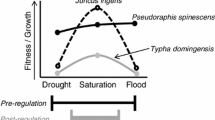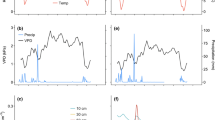Abstract
Efforts to maximize or restore ecological function on floodplains impacted by dam construction have increasingly focused on river flow management. Few studies, however, consider floodplain hydrogeomorphic position and annual climatic variation in dam impact assessment. The Savannah River, a large river ecosystem in the Southeastern United States, was impounded in the 1950’s. Our study objectives were: (1) Characterize hydrology in floodplain areas containing Taxodium distichum, and determine how it has been affected by dam operations; (2) Identify basal area increment (BAI) response of Taxodium to annual flooding and climate (dry, average, wet) conditions; (3) Assess BAI response to dam-induced hydrologic changes. Levee and backswamp sites were significantly drier in the post-dam era, and trees at these sites showed a significant post-dam increase in BAI. Low-elevation river sites did not show significant hydrologic differences between pre- and post-dam eras, but BAI was significantly higher in dry years and significantly less sensitive to hydroperiod in the post-dam era. All trees demonstrated a significant quadratic BAI vs. hydroperiod relationship. This study demonstrates that annual productivity of Taxodium trees can be reduced by either drought or flood stress. It also suggests that climate and hydrogeomorphic location mediate dam impacts and productivity-flooding relationships in Taxodium.



Similar content being viewed by others
References
Bayley PB (1995) Understanding large river-floodplain ecosystems. Bioscience 45:153–159
Birch JB, Cooley JL (1983) The effect of hydroperiod on floodplain forest production. Technical Completion Report USDI/OWRT, Project No. B-155-GA. Institute of Ecology, University of Georgia, Athens
Brantley CG, Day JW, Lane RR, Hyfield E, Day JN, Ko JY (2008) Primary production, nutrient dynamics, and accretion of a coastal freshwater forested wetland assimilation system in Louisiana. Ecological Engineering. doi:10.1016/j.ecoleng.2008.05.004
Brown S (1981) A comparison of the structure, primary productivity, and transpiration of cypress ecosystems in Florida. Ecological Monographs 51:403–427
Conner WH, Day JW (1992) Diameter growth of Taxodium distichum (L.) Rich. and Nyssa aquatica L. from 1979–1985 in four Louisiana swamp stands. American Midland Naturalist 127:290–299
Day RH, Doyle TW, Draugelis-Dale RO (2006) Interactive effects of substrate, hydroperiod, and nutrients on seeding growth of Salix nigra and Taxodium distichum. Environmental and Experimental Botany. doi:10.1016/j.envexpbot.2004.10.009
Donovan LA, Stumpff NJ, McLeod KW (1989) Thermal flooding injury of woody swamp seedlings. Journal of Thermal Biology. doi:10.1016/0306-4565(89)90037-5
Effler RS, Goyer RA (2006) Baldcypress and water tupelo sapling response to multiple stress agents and reforestation implications for Louisiana swamps. Forest Ecology and Management. doi:10.1016/j.foreco.2006.02.011
Elcan JM, Pezeshki SR (2002) Effects of flooding on susceptibility of Taxodium distichum L. seedlings to drought. Photosynthetica. doi:10.1023/A:1021381204684
Grissino-Mayer HD (1997) Computer assisted, independent observer verification of tree-ring measurements. Tree-Ring Bulletin 54:29–41
Hale VC, Jackson CR (2003) Hydrologic modifications to the lower Savannah River. In: Hatcher KJ (ed) Proceedings of the 2003 Georgia Water Resources Conference. University of Georgia, Athens
Harms WR, Schreuder HT, Hook DD, Brown CL, Shropshire FW (1980) The effects of flooding on the swamp forest in Lake Ocklawaha, Florida. Ecology 61:1412–1421
Harrel JB, Allen CM, Hebert SJ (1996) Movements and habitat use of subadult alligator snapping turtles (Macroclemys temminckii) in Louisiana. American Midland Naturalist 135:60–67
Holmes RL (1983) Computer-assisted quality control in tree-ring dating and measurement. Tree Ring Bulletin 43:69–78
Jones RH, Sharitz RR, Dixon PM, Segal DS, Schneider RL (1994a) Woody plant regeneration in four floodplain forests. Ecological Monographs 64:345–367
Jones RH, Sharitz RR, James SM, Dixon PM (1994b) Tree population dynamics in seven South Carolina mixed-species forests. Bulletin of the Torrey Botanical Club 121:360–368
Junk WJ, Bayley PB, Sparks RE (1989) The flood pulse concept in river-floodplain systems. Canadian Special Publication of Fisheries and Aquatic Sciences 106:110–127
Keeland BD, Young PJ (1997) Long-term growth trends of baldcypress (Taxodium distichum (L.) Rich.) at Caddo Lake, Texas. Wetlands. doi:10.1007/BF03161522
Keeland BD, Conner WH, Sharitz RR (1997) A comparison of wetland tree growth response to hydrologic regime in Louisiana and South Carolina. Forest Ecology and Management. doi:10.1016/S0378-1127(96)03901-1
Li C, Zhong Z, Geng Y, Schneider R (2010) Comparative studies on physiological and biochemical adaptation of Taxodium distichum and Taxodium ascendens seedlings to different soil water regimes. Plant and Soil. doi:10.1007/s11104-009-0174-z
Lugo AE (1978) Stress and ecosystems. In: Thorp JH, Gibbons JW (eds) Energy and environmental stress in aquatic systems. US Department of Energy, Washington, D.C., pp 62–101
McArthur JV, Moorhead KK (1996) Characterization of riparian species and stream detritus using multiple stable isotopes. Oecologia 107:232–238
McLeod KW, Reed MR, Wike LD (2000) Elevation, competition control, and species affect bottomland forest restoration. Wetlands. doi:10.1672/0277-5212(2000)020[0162:ECCASA]2.0.CO;2
Megonigal JP, Day FP (1992) Effects of flooding on root and shoot production of bald cypress in large experimental enclosures. Ecology 73:1182–1193
Megonigal JP, Conner WH, Kroeger S, Sharitz RR (1997) Aboveground production in Southeastern floodplain forests: a test of the subsidy-stress hypothesis. Ecology 78:370–384
Meyer J, Alber M, Duncan W, Freeman M, Hale C, Jackson R, Jennings C, Palta M, Richardson E, Sharitz R, Sheldon J, Weyers R (2003) Summary report supporting the development of ecosystem flow recommendations for the Savannah River below Thurmond Dam. Report to The Nature Conservancy, Savannah
Mitsch WJ, Ewel KC (1979) Comparative biomass and growth of cypress in Florida wetlands. American Midland Naturalist 101:417–426
Mitsch WJ, Rust WG (1984) Tree growth-responses to flooding in a bottomland forest in northen Illinois. Forest Science 30:499–510
Mitsch WJ, Dorge CL, Wiemhoff JR (1979) Ecosystem dynamics and a phosphorus budget of an alluvial cypress swamp in southern Illinois. Ecology 60:1116–1124
Odum EP, Finn JT, Franz EH (1979) Perturbation theory and the subsidy-stress gradient. Bioscience 29:349–352
Palmer WC (1965) Meteorological drought. Research Paper No. 45, U.S. Department of Commerce Weather Bureau, Washington, D.C.
Pezeshki SR (1991) Root responses of flood-tolerant and flood-sensitive tree species to soil redox conditions. Trees-Structure and Function 5:180–186
Pezeshki SR, DeLaune RD, Anderson PH (1999) Effect of flooding on elemental uptake and biomass allocation in seedlings of three bottomland tree species. Journal of Plant Nutrition. doi:10.1080/01904169909365729
Poff NL, Bledsoe BP, Cuhaciyan CO (2006) Hydrologic variation with land use across the contiguous United States: Geomorphic and ecological consequences for stream ecosystems. Geomorphology. doi:10.1016/j.geomorph.2006.06.032
Richter BD, Mathews R, Wigington R (2003) Ecologically sustainable water management: managing river flows for ecological integrity. Ecological Applications 13:206–224
Richter BD, Warner AT, Meyer JL, Lutz K (2006) A collaborative and adaptive process for developing environmental flow recommendations. River Research and Applications. doi:10.1002/rra.892
SAS Institute (2008) Version 9.2. SAS Institute, Cary
Schneider RL, Sharitz RR (1988) Hydrochory and regeneration in a bald cypress-water tupelo swamp forest. Ecology 69:1055–1063
Shanklin J, Kozlowski TT (1985) Effect of flooding of soil on growth and subsequent responses of Taxodium distichum seedlings to SO2. Environmental Pollution (Series A) 38:199–212
Sharitz RR, Schneider RL, Lee LC (1990) Composition and regeneration of a disturbed river floodplain forest in South Carolina. In: Gosselink JG, Lee LC, Muir TA (eds) Ecological processes and cumulative impacts. Lewis Publishers Inc, Chelsea, pp 195–218
Stahle DW, Cleaveland MK (1992) Reconstruction and analysis of spring rainfall over the Southeast U.S. for the past 1000 years. Bulletin of the American Meteorological Society. doi:10.1175/1520-0477(1992)073<1947:RAAOSR>2.0.CO;2
Stahle DW, Cleaveland MK, Hehr JG (1988) North Carolina climate changes reconstructed from tree rings: A.D. 372 to 1985. Science. doi:10.1126/science.240.4858.1517
Stahle DW, VanArsdale RB, Cleaveland MK (1992) Tectonic signal in baldcypress trees at Reelfoot Lake, Tennessee. Seismological Research Letters 63:439–447
Stokes MA, Smiley TL (1968) An introduction to tree-ring dating. University of Chicago Press, Chicago
Teskey RO, Bongarten BC, Cregg BM, Dougherty PM, Hennessey TC (1987) Physiology and genetics of tree growth response to moisture and temperature stress: an examination of the characteristics of loblolly pine (Pinus taeda L.). Tree Physiology. doi:10.1093/treephys/3.1.41
Townsend PA (2001) Relationships between vegetation patterns and hydroperiod on the Roanoke River Floodplain, NC. Plant Ecology. doi:10.1023/A:1011996822576
US Army Corps of Engineers (1992) Reconnaissance Report: Lower Savannah River Environmental Restoration. Savannah District, South Atlantic Division
Young PJ, Keeland BD, Sharitz RR (1995) Growth response of baldcypress [Taxodium distichum (L.) Rich.] to an altered hydrologic regime. American Midland Naturalist 133:206–212
Acknowledgments
We thank Paul Stankus, Will Duncan, Kimberly Andrews, Nick Lumley, Cub Stephens, Gayle Albers, Jeff Diez, Jamie Williams, and Paul Koehler for field assistance. Thanks also to the Savannah River Ecology Lab, Cowden Plantation, and Silver Bluff Plantation, for use of field sites and equipment; Mari Palta, for assistance in statistical analysis; and Will Conner, for providing comments on earlier drafts of this article. Manuscript preparation was aided by Financial Assistance Award No. DE-FC09-96SR18546 between the U.S. Department of Energy and the University of Georgia.
Author information
Authors and Affiliations
Corresponding author
Electronic supplementary material
Below is the link to the electronic supplementary material.
ESM 1
(PDF 715 kb)
Rights and permissions
About this article
Cite this article
Palta, M.M., Doyle, T.W., Jackson, C.R. et al. Changes in Diameter Growth of Taxodium distichum in Response to Flow Alterations in the Savannah River. Wetlands 32, 59–71 (2012). https://doi.org/10.1007/s13157-011-0245-9
Received:
Accepted:
Published:
Issue Date:
DOI: https://doi.org/10.1007/s13157-011-0245-9




